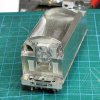Dave Holt
Western Thunderer
The inner chassis has been rebuilt to face the correct way round and proof of the effectiveness of the rebuild is shown in the photo below.
More crucially, it shows that the Lanarkshire Models inner chassis has been successfully married up to the Brassmasters footplate and outer chassis. This was the main issue to resolve in the whole tender construction. The LMS inner chassis is really designed to fit the Bachmann RTR Stanier tender, where it fits directly under the tender footplate. The Brassmasters tender has the body, outer chassis and inner chassis as three separate units, held together with screws through three layers. To accommodate the LMS inner chassis, the top of the outer chassis has had to be cut away at each end, to allow the inner chassis to pass through, and will be soldered to the underside of the footplate, in effect becoming a permanent part of the body.
One new fixing screw position has had to be made in the footplate and a couple of dowel pins accurately locate the inner chassis relative to the footplate.

I can now either complete the LMS inner chassis or assemble the inner body of the Brassmasters kit. Choices, choices!
Dave.
More crucially, it shows that the Lanarkshire Models inner chassis has been successfully married up to the Brassmasters footplate and outer chassis. This was the main issue to resolve in the whole tender construction. The LMS inner chassis is really designed to fit the Bachmann RTR Stanier tender, where it fits directly under the tender footplate. The Brassmasters tender has the body, outer chassis and inner chassis as three separate units, held together with screws through three layers. To accommodate the LMS inner chassis, the top of the outer chassis has had to be cut away at each end, to allow the inner chassis to pass through, and will be soldered to the underside of the footplate, in effect becoming a permanent part of the body.
One new fixing screw position has had to be made in the footplate and a couple of dowel pins accurately locate the inner chassis relative to the footplate.
I can now either complete the LMS inner chassis or assemble the inner body of the Brassmasters kit. Choices, choices!
Dave.




















